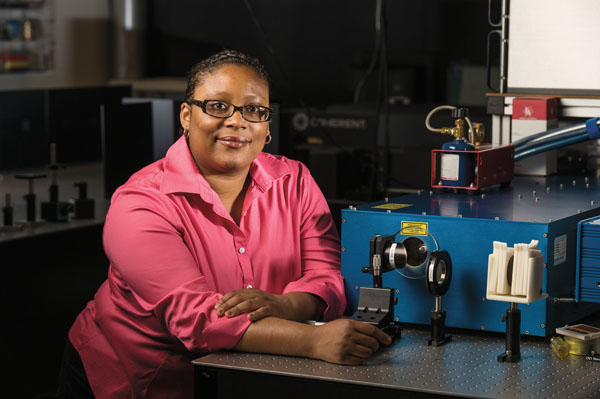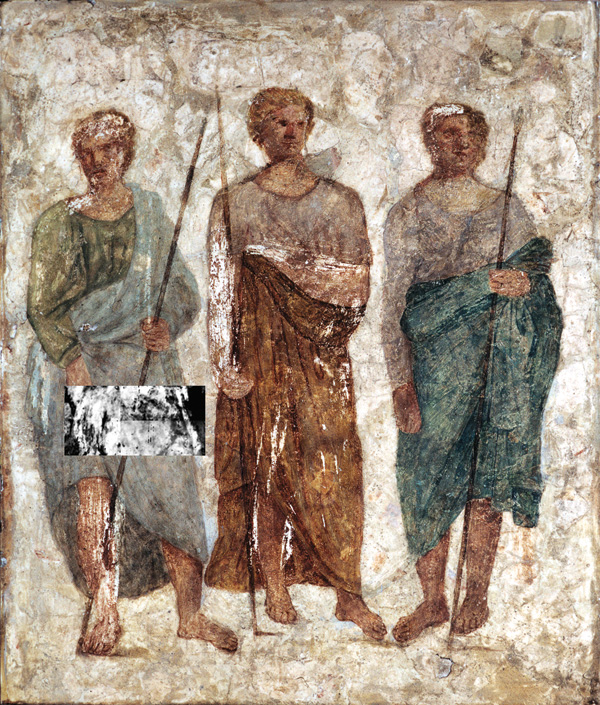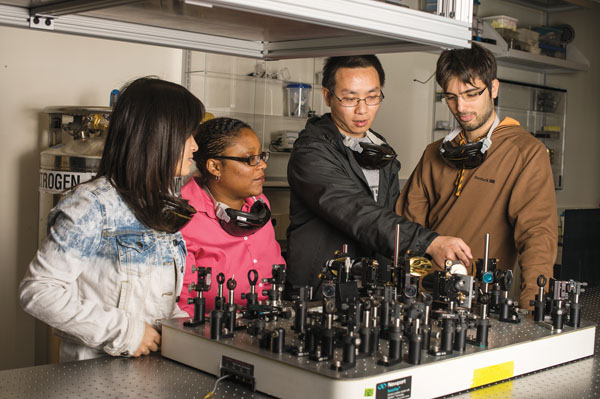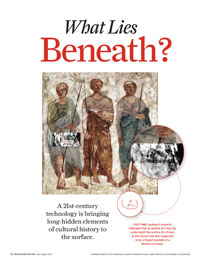Features
 SCIENTIFIC IMAGE: “I like the idea of a gentle form of science, of a gentle form of imaging,” Jackson says of using terahertz technology to analyze cultural and historical artifacts. (Photo: Adam Fenster)
SCIENTIFIC IMAGE: “I like the idea of a gentle form of science, of a gentle form of imaging,” Jackson says of using terahertz technology to analyze cultural and historical artifacts. (Photo: Adam Fenster)Bianca Jackson was ready to give up on the “Three Men.” Now a postdoc- toral researcher at the Institute of Optics, she had analyzed seven sections of the fresco in the Louvre with nothing to show for her efforts but a growing sense that maybe the faded paint and plaster had no secrets to yield to her scanning technology after all.
As she worked across the painting, Jackson moved a carefully controlled beam of terahertz pulses across a postcard-sized section of the fresco and repeated a time-consuming cycle of recording the signal as it was reflected to her equipment. There, a computer program she wrote calculated the maximum amplitude of each returning pulse, adjusted the noise-to-signal ratio, and presented a pixel-by-pixel string of data across her laptop screen.
“I was ready to give up because we weren’t really seeing anything, and you have to keep doing the same thing to each section,” Jackson says from her office in Goergen Hall. “If the layers are very thin and very close, what you’re looking for is very hard to identify. I think I was on the eighth one when we started to see something.”
That “something” made international news this spring when Jackson reported the results at the American Chemical Society’s national meeting. She and her colleagues reported that below the surface of the left hip of one of the Romanesque men in the fresco, “Trois hommes armes de lances” (“Three Men with Lances”), the signals indicated the outline of what appeared to be a face. At a depth of a fraction of a millimeter, the equipment picked up a noticeable difference, a change in contrast, between the fresco’s plaster and another material that formed the outline of what seemed to be a separate, older work of art.
Was it possible that someone had painted over an original Roman-era work of art?
“We could not believe our eyes as the image evolved on the screen,” Jackson says. “We were seeing what likely was part of an ancient Roman fresco, thousands of years old.”
Using new technology to peer—at least metaphorically—into layers of cultural, archaeological, and artistic history has become something of a specialty for Jackson. A leading researcher on the use of terahertz imaging to examine historical artifacts and paintings, she has traveled the world during the past half decade, honing the application of the technology as a potential research tool for archaeologists, historians, art conservators, and curators.
 FACE TIME: Jackson’s research indicated that an outline of a face lay underneath the surface of a fresco at the Louvre that was suspected to be a forged example of a Roman-era work. (Photo: Dominique Martos-Levif and Bianca Jackson (terahertz scan); C2RMF (fresco))
FACE TIME: Jackson’s research indicated that an outline of a face lay underneath the surface of a fresco at the Louvre that was suspected to be a forged example of a Roman-era work. (Photo: Dominique Martos-Levif and Bianca Jackson (terahertz scan); C2RMF (fresco))In addition to the Louvre, she has undertaken research at Çatalhöyük, Turkey, a 9,000-year-old U.N. World Heritage site that’s considered the oldest example of a Neolithic-era human settlement; she’s scanned for decorative motifs that were painted over at an 800-year-old medieval cathedral in Riga, Latvia, and scanned Orthodox icons in Nizhny Novgorod, Russia; she’s climbed to the top of Chartres Cathedral in France for a project; and she’s demonstrated the technology’s possibilities by scanning Egyptian bird mummies at the Oriental Institute at the University of Chicago.
Gerard Mourou, a former faculty member at the Institute of Optics who is now a professor of physics and the director of the International Center for Zetta-Exawatt Science and Technology at the Ecole Polytechnique in Paris, says Jackson was one of the first researchers to demonstrate that terahertz technology could be used to identify “undercover” art—images that have been covered over by layers of paint, plaster, and other materials.
“She won’t tell you this, but she really is a pioneer,” Mourou says. “Bianca introduced a new electromagnetic frequency band to the archaeologists’ panoply. She’s made seminal contributions to the field.”
While terahertz technology is probably best known for its potential use in some scanning machines in airport security lines, the field has been undergoing a scientific renaissance since the 1980s. Historically considered something of a “gap” when it came to understanding the electromagnetic spectrum, the terahertz band lies between frequencies that can be readily measured electronically with antennas or optically with detectors. Falling between microwaves, like those used in the common kitchen appliances, and the infrared light used in TV remote controls, the terahertz frequency region is invisible to humans.
And like all physical phenomena that are part of a spectrum, terahertz radiation not only shares properties of nearby frequencies but also has properties that set it apart. That’s tantalizing for researchers hoping to capitalize on its potential.
On the plus side, terahertz frequencies are relatively weak as far as electromagnetic radiation goes. Unlike x-rays or ultraviolet radiation, terahertz waves don’t “energize” the electrons of the molecules that absorb them. That means those electrons don’t change their state, altering the underlying atomic structure in the way that living tissue can be affected by x-ray radiation or a work of art will change color if left exposed to the sun. Also in the plus column, terahertz waves travel deeply into dense material, transmitting especially well in materials that contain little moisture.
On the minus side, while terahertz waves propagate, their higher frequencies are easily absorbed by water and other molecules in Earth’s atmosphere, meaning that unlike microwaves or radio waves, they can’t travel far in the open air. And because terahertz radiation has relatively large wavelengths—on the order of 300 to 1,000 times larger than infrared and ultraviolet—the level of detail at which terahertz images can be resolved is more limited than that of other imaging technology.
Xi-Cheng Zhang, the director of the Institute of Optics who is considered one of the leading experts in understanding the terahertz band, recognizes the trade-offs, but he says the technology has proven itself in several applications beyond imaging, particularly for quality control, nondestructive testing, and other manufacturing processes.
“I like to talk about terahertz technology as a complementary method to x-ray and infrared spectroscopy,” says Zhang, the M. Parker Givens Professor of Optics. “There are certain materials for which terahertz wave technology does a better job than x-ray or infrared. For example, for low-contrast materials, such as low-density foam, terahertz wave technology has been demonstrated as having a better contrast ratio than x-ray images; on the other hand, for infrared imaging of some optical opaque materials, such as paper, plastics, or cloth, terahertz penetration capability is better. That’s why now many airports use sub-terahertz wave imaging, and why we continue to push the frequency to the terahertz range.”
Working with terahertz pioneer David Auston and others at Columbia University in the late 1980s, Zhang was among the first to demonstrate that terahertz signals could be consistently generated and measured using semiconducting materials and lasers. In 2012, he brought his internationally regarded program to Rochester when he moved to the Institute of Optics after a 20-year career at Rensselaer Polytechnic Institute, where he was director of the Center for Terahertz Imaging, acting head of physics, applied physics, and astronomy, and the Erik Josson Professor of Science.
He and his group are currently leading work to explore whether terahertz technology can be harnessed for remote sensing and long-distance communications. Zhang invited Jackson to spend a year working at Rochester after learning about her work with terahertz imaging on several cultural heritage projects. He considers her work as part of a larger effort to build strength in terahertz at Rochester.
In many ways Zhang’s initiative taps into a larger history of leadership in terahertz research at Rochester. As a scientist at the Laboratory for Laser Energetics in the 1970s, Mourou led a team that reported the first work in producing and detecting terahertz pulses. In 1988, he moved to the University of Michigan in Ann Arbor, where one of his former students, Steve Williamson ’82, would later found Picometrix, one of the world’s leading manufacturers of terahertz equipment. The company’s key principals also include Irl Duling ’85 (PhD) and Janis Valdmanis ’84 (PhD). In 2005, Picometrix was purchased by Advanced Photonix Inc., a public company.
At Michigan, Mourou first met Jackson, whose PhD advisor was John Whitaker ’88 (PhD), a scientist at Michigan’s Center for Ultrafast Optical Science. Whitaker himself had worked on applications of terahertz radiation in electrical transmission lines as a graduate student in electrical and computer engineering at Rochester.
“It’s like a circle almost,” Jackson says of the connections between Rochester, Michigan, and terahertz research.
In the mid-2000s, Mourou had returned from a conference at the Hermitage in St. Petersburg, Russia, where he had heard the latest research on using infrared, ultraviolet, x-rays, and other frequencies to image art work and historical objects, and he had an idea: could pulsed terahertz waves be used for imaging cultural artifacts? He turned to Whitaker, who had been advising Jackson on terahertz-based work to examine the ceramic coatings of jet engine turbine blades.
“We were basically looking for defects in the coatings on the blades,” says Whitaker.
He suggested to Jackson that she undertake the research on artwork. To do that, Jackson and Mourou’s daughter established a mini-art studio in the Michigan lab, using historically accurate painting materials and compounds to draw and paint images, such as butterflies, and then cover part of each work with different kinds of plaster, including gypsum, the mineral in modern drywall that’s also found in the plaster at the Neolithic site in Turkey.
“Visibly, you would see half of a sketch, and then white plaster,” Whitaker says. But with the terahertz equipment, it was possible to “see” more. “Even though it was under the plaster, you could still see the image of the butterfly.”
Says Jackson: “We would have a 4- or 5-millimeter thick piece of plaster, and we could see the paint patterns behind it.”
The findings were promising for imaging, Whitaker says, but they also demonstrated that pulsed terahertz waves could be used for spectroscopy, or analyzing the molecular make-up of materials by the frequency at which they reflect electromagnetic radiation. By “tuning” the frequencies at which the pulses were emitted, Jackson could examine the makeup of individual compounds under the plaster, the “nitty-gritty spectroscopy of plaster and pigment.”
“One of the beauties of using terahertz pulsed imaging to look at art is that you’re not only doing imaging, but you’re also doing spectroscopy at the same time,” Whitaker says.
Understanding the relationships among fre- quencies and the contrasting properties of different types of materials when they absorb radiation is a key area of research, Jackson says.
“When you see something, you’re not really seeing the ‘thing,’” she says of one of the tenets of imaging science. “You’re seeing the difference between the ‘thing’ and what’s around it. If you have two materials that are very similar and neither of them is particularly absorbing, it’s going to seem like the ‘thing’ is invisible or transparent. You may see edges, but you won’t really see the whole object.”
For example, with x-rays, materials like plastics and polymers are difficult to detect because the materials do not absorb much of the radiation. In other words, the atomic density of plastic is closer to air than it is to something more substantial like bones, brick, or metal, allowing the radiation to pass through it.
“With terahertz, the structure of the material—the specific atoms that make up the material—aren’t as significant,” says Jackson. “So you can have carbon-based materials or organic materials that are very visible with terahertz because there’s still some absorption, there’s still some contrast between that material and the air around it.”
To analyze paintings, the molecular composition of some pigment compounds traditionally used by artists, such as red iron oxide, aka “red ochre,” have very low contrast when it comes to imaging. On the other hand, a fundamentally similar one, like iron oxide hydroxide, aka “yellow ochre,” might be identified well.
“So red ochre, no; yellow ochre, yes,” says Jackson. “That’s the kind of information I started picking up from my early experiments.”
An early idea to scan the Mona Lisa, for example, eventually failed to come to fruition after Jackson found that if Leonardo DaVinci used red ochre, as was traditional for him and other artists of his era, indications of drawings underneath the surface paint would be nearly impossible for her to pinpoint.
After graduating from Michigan, Jackson began working in the field, where she discovered that, because most art exists in a world of clumps, splotches, and uneven surfaces, much of her work requires fine-tuning computer algorithms to adjust for such variables, a programming challenge that she takes on herself.
“Terahertz works well for layered artifacts, like old wall paintings, because it can scan at different depths,” Jackson says. “As work is painted or plastered over, each new addition adds a layer. Sometimes the previous work was erased, but sometimes it was simply plastered over. At sites like Çatalhöyük, that means centuries of plaster.”
That requires developing new algorithms to account for the layering, which colleagues reported with Jackson this spring in the journal Optics Express.
 TEACHER: As part of her work, Jackson teaches in a terahertz lab, where Jing Zhang, a visiting PhD student from Huazhong University
of Science and Technology (pointing), and Rochester optics PhD students Xuan (Betty) Sun (left) and Fabrizio Buccheri conduct
research. (Photo: Adam Fenster)
TEACHER: As part of her work, Jackson teaches in a terahertz lab, where Jing Zhang, a visiting PhD student from Huazhong University
of Science and Technology (pointing), and Rochester optics PhD students Xuan (Betty) Sun (left) and Fabrizio Buccheri conduct
research. (Photo: Adam Fenster)On the minus side, while terahertz waves propagate, their higher frequencies are easily absorbed by water and other molecules in
From academic positions in France and elsewhere, Jackson has become a go-to person in the world of terahertz applications in cultural heritage. For the “Three Men” project, curators from the Louvre had turned to her and her team to evaluate the fresco—part of the Louvre’s collection of pieces that once belonged to 19th-century collector Giampietro Campana—because they knew it was not an authentic Roman-era work. Art historians have long known that Campana was not above “restoring” pieces in his collection because he thought it important to save historical work such as frescoes.
Working with a portable system made by Picometrix, Jackson was able to conduct her work within the Louvre, something that she sees as an important benefit to terahertz imaging. With other scanning technologies, like x-rays or computer tomography (CT) scans, artwork has to be taken to the equipment, usually requiring transportation to a hospital setting. That can make curators and conservators uneasy about letting researchers examine artifacts that are often priceless and one-of-a-kind, and sometimes too large to move.
Jack Green, chief curator at the Oriental Institute Museum, says that conservators have long been interested in being able to “dissect objects digitally,” especially for artifacts like mummies, which cannot be opened without destroying them. The Oriental Institute invited Jackson to scan a 2,000-year-old Egyptian bird mummy as part of a larger research project on the institute’s collection of Egyptian artifacts. While the fragile mummies had to be transported to the University of Chicago’s hospitals to undergo CT scanning, Jackson conducted her work in the institute’s conservation lab. Jackson contributed a chapter to the catalog for the exhibition, Between Heaven and Earth: Birds in Ancient Egypt, on display at the Oriental Institute through July 28.
The results were not as detailed as the CT scanning, but Green says experimenting with new technologies is important to understanding cultural history. Jackson and the exhibition’s guest curator, Rozenn Bailleul-LeSeur, plan to conduct a more detailed comparison of the CT scanning and terahertz imaging that was done on the bird mummy. “Obviously, we favor nondestructive testing,” Green says. “And a tool like this can be incredibly useful if you’re able to reveal information about the object layer by layer.”
Gillian Walker, a researcher at the School of Systems Engineering at the University of Reading in the United Kingdom and a frequent collaborator with Jackson, says the noninvasive nature of terahertz imaging is one of its most compelling features. One of her first projects was trying to develop a way to detect skin cancer using terahertz imaging. “The mathematical problem is exactly the same as detecting layers of paint in plaster,” Walker says.
And although she’s intrigued by the opportunity to help conservators and archaeologists gain new insights into cultural history, “how that enhances the study of cultural history and archaeology is up to the archaeologists to decide,” she says. “But it is where the impact of my work is, so it is important to work with good experts who are open and able to interpret the data I provide.”
Whitaker says he expects terahertz data will become increasingly prevalent, particularly in areas such as biomedical imaging, the pharmaceutical industry, and in materials testing and quality control. Two challenges to address, he notes, include enhancing the power that terahertz systems can produce and improving the signal processing of the systems.
“Improving the signal-to-noise ratio is crucial,” Whitaker says, noting “that’s also something that will improve the resolution of the images over time.”
Jackson says she’s up for the challenge, excited by the chance to demonstrate the applicability of science and research to a problem that improves other people’s lives. When people ask about her work, “I always say ‘I do terahertz.’ I think it’s great technology.”
“I’ve always been interested in science and cultural history,” says Jackson, who describes her father as a “techie person” who taught her how to program using the BASIC computer language when she was in elementary school. Her mother is an artist who made her living as an art history teacher and who often had her students try to reproduce artifacts as a way of understanding art.
“So it worked out that I was able to use both sides of my brain growing up,” Jackson says.
“But as a scientist, I’m interested in being innocuous, but also being helpful and useful. I like the idea of a gentle form of science, of a gentle form of imaging. After 9/11, I think the interest in using the technology in providing a service and in making people safer gave me more incentive.”
In 2014, she begins a Marie Curie Fellowship IntraEuropean, a program of the European Commission to support the work and geographic mobility of young investigators. She will be based at the University of Reading.
At Reading, Walker has finished scanning St. Thomas’s Church in Salisbury with the French team, and has scheduled work to scan a contemporary work of art and a church in France this summer. Jackson will inherit the data about the Salisbury Church.
“I tend to think of myself as being more aligned with terahertz and being a promoter of terahertz,” says Jackson. “But I like having fun. I like art. I like traveling. But that’s mostly secondary to someone who wants to promote terahertz.”

